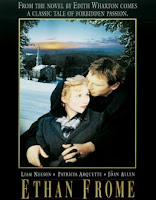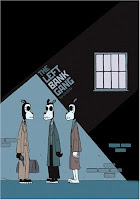 ** A word before the review: happy almost 2012, all! Sometime soon, I'll post the full list of what I read in 2011, as well as highlighting some of my favorite reads. **
** A word before the review: happy almost 2012, all! Sometime soon, I'll post the full list of what I read in 2011, as well as highlighting some of my favorite reads. **The Book: Tinker, Tailor, Soldier, Spy (The Karla Trilogy, #1)
The Author: John le Carre
How I Found It: The movie had quite a few British actors I love; there was no way I wasn't seeing it! I decided, as I almost always do, to read the book first.
The Review: George Smiley is retired from MI6, known here as "the Circus." He worked on the top floor, the right hand man of the eternally and unfortunately paranoid Control. Control, as it turns out, was right to be suspicious: one of five men could be a mole for the Soviets, and all of those men are on the top floor. There's Percy Alleline, Control's successor ("Tinker"); Bill Haydon, charming and duplicitous ("Tailor"); Roy Bland and Toby Esterhase, always together ("Soldier" and "Poor Man") . Even Smiley ("Beggar Man") is not above Control's suspicions.
No one's supposed to know about the potential mole, but as it turns out, someone does: a woman in Russia named Irina, a woman Circus agent Ricki Tarr wants to protect. He returns to England to reveal what he knows, the explosive truth that Irina has told him. Smiley, as a retiree, is well-placed to look into the conspiracy, whether or not he wants to, and recruits a fellow retiree named Mendel and a younger agent, Peter Guillam, to help him.
As Smiley digs deeper and deeper into the mystery, he learns that Control wasn't the only one with suspicions--a now-retired researcher, Connie, had grown suspicious of a supposed Russian cultural attache and subsequently got harshly warned off his tail; Jerry Westerby, a reporter, learned some suspicious truths about the shooting of Jim Prideaux, another Circus agent; and Prideaux's shooting might not be as unconnected to the search for the mole as it may seem. Smiley and his associates are treading on dangerous ground, looking into something some people would really prefer they not look into. If they find the mole, the security of an entire nation will once more be safe--but what will happen to the Circus, and to all the men involved?
When I started reading this one, I got the feeling that I was out of my depth just a bit. I don't know overmuch about the Cold War; I don't know much about British intelligence agencies (I don't even have that much of an acquaintance with James Bond); and I don't believe I'd ever read a proper spy novel. The jargon confused me (bless my mother for finding a promotional thing for the movie that gave pictures, names, and biographies of all the important characters and a glossary for said jargon!) and some of the period language was lost on me. Even with all of those difficulties, though, I found myself with a feeling I hadn't had in a while. I read the first chapter and I started wondering about how it would fit in with the rest of the book. What did a schoolteacher at a boys' school have to do with a book about spies? These days, as can be seen here, I tend to stick with books like Jane Austen or Doctor Who, where I know the characters and can usually guess where the plot is going, but I had no idea here. I was drawn in by that mystery, and I think that helped me stick it out even past the confusion.
Though the book took me longer than average to get through, and I found that I had to take it slowly in order to comprehend it and not get frustrated, I found that I really did enjoy it, and since I finished it and have started reading other things, I've found myself missing le Carre's style of language and plotting! What first made me like it was the characters. I instantly fell for Jim Prideaux; his kindnesses to the boys at the school he works at endeared him to me, and I was curious to know more about him. George Smiley won my sympathies right off; his philandering wife and the descriptions of his day-to-day routine made him feel real to me, and I wanted to see if he was indeed as good as Control had believed.
I was stunned, as I read it, that this had been made into a successful miniseries and a then-pending release film. There's really no action sequences in the book at all, and the majority of the information we get comes from flashbacks and reading files. I couldn't imagine how such a cerebral, silent story would transition to film. This wasn't like any spy story that I could think of, although I'll reiterate that my experience with that field is narrow. There's no gadgets; there's not a huge amount of shooting guns and other dirty work. This felt realistic, and I know that was le Carre's goal. (As I write this review, I've been back for a few hours from a viewing of Mission: Impossible - Ghost Protocol, and I walked out grumbling that it felt too unrealistic so soon after I read and saw Tinker, Tailor.) Even if I was stunned by how little action there was, I was amazed at how well the suspense worked. I'm pretty sure I jumped and mumbled a few curses during a tense scene where Peter Guillam steals a file for Smiley, and there's a fantastically eerie sequence where Prideaux recounts the realization that he was being followed while on a mission. Like I said, there's no true action sequences, but damn if I wasn't sold by le Carre's mastery of suspense.
I realized, after all, that I really did like the way le Carre did it--the reader comes to know about each suspect as Smiley digs into their pasts, serving as a reminder to him and an introduction to us. Information is given to the reader naturally--for example, as Smiley reads the files, or as he tells the story of his prior encounters with Karla to Guillam, who's younger and thus doesn't know the story--and it never felt clunky or like it was just a ton of exposition that had to be gotten out of the way. I'm planning on reading the rest of the trilogy, and possibly other classics by le Carre, based solely on how expertly he relayed the information and how he kept me guessing (I thought for sure I'd figured out who the mole was; I was half-right, in a way, but surprised ultimately at who it turned out to be!). The book was well-structured and certainly different than any other mystery or suspense novel I'd read before.
As for the movie, I was pleasantly surprised, even with my misgivings about how the story would transition to film. I've not yet seen the miniseries (that is coming in future), but I was lucky enough to see the film. Like the book, it is very slowly paced (something many British critics had a problem with, and a few people in my theater fell asleep), but if you're willing to stick it out, it's an adaptation that, while not entirely faithful (spoilers ahoy, but if you want a point-by-point list written by a very brutal reviewer, go here), is really worth seeing for the talent involved and to see how such an internalized story made its way on screen.
The men who brought the story to life were all known to me from prior productions, and all of them were outstanding. Gary Oldman managed to convey so much with his silences and calm, contemplative stares; one critic was keen to point out that he doesn't even speak a word until eighteen minutes in. His confrontations and oddly calm interrogations were almost chilling to watch--Smiley is so very mild-mannered, but he has a way of being quietly forceful that Oldman played brilliantly. Colin Firth, as Bill Haydon, was appropriately charismatic and shifty; the other three men (Toby Jones, Ciaran Hinds, David Dencik) were threatening shadows in the background.
After Atonement and Sherlock, I didn't need to be convinced about Benedict Cumberbatch's abilities, but his interpretation of Peter Guillam was probably my favorite performance to watch. I felt the same tension during the file stealing scene that I did in the book, and the filmmakers made one crucial change to his character that made me feel really deeply for him. Just behind Cumberbatch's Guillam in my estimation was Mark Strong's take on Prideaux. I worried about him in this role, as I've mostly seen him in villainous roles (and, oddly, as Mr. Knightley in Emma) and I wasn't sure if I'd be able to believe him as a decent guy. But he played his scenes with Bill Roach, the young boy he takes under his wing, exceptionally well, bringing to life the Prideaux from the book that I'd loved right away, and flashbacks to his ordeals and certain subtexts the filmmakers added made me feel very sad for him indeed.
Some things are definitely trimmed (we don't get much of anything about the backstories of any of the suspects, unlike in the book; some characters become composites due to time constraints), but I felt the adaptation hit all the important points of the story, and there was nothing I greatly missed, something I can't say about most adaptations of books I loved. The score was excellent and added a sense of foreboding to the narrative, and the gorgeous locales and snippets of different languages (Russian! Hungarian!) added the foreign flavor that was sometimes difficult for me to visualize as I read, not having much familiarity with those areas. The film certainly helped me make sense of some of the more labyrinthine aspects of the story, and if the book gets to be too much for a person to follow, I would recommend perhaps giving the film a shot beforehand.
This book and the accompanying film was an entirely new experience for me, and one I greatly enjoyed. I'm definitely sold on reading more le Carre (one of my holiday giftcards is going towards The Honourable Schoolboy, the second book of the trilogy), and I'd really like to see if other film(s) in the series come to fruition. If you're curious to read a classic of the spy genre or you just want to see what story has attracted so many talented British men, give this one a try!













